Recent Progress in the Preparation Technologies for Micro Metal Coils
Abstract
1. Introduction
2. Type and Theory of Micro Metal Coil Construction
2.1. Theory of Coil Performance
2.2. The Solenoid
2.3. Planar Micro Metal Coil
2.4. Integrated Micro Coil with Flexible Substrates
3. Main Processing Method
3.1. Macro Production Mode
3.1.1. Processing on PCB
3.1.2. Wire-Wound Coils
- (1)
- Hand winding
- (2)
- Wire Bonding
3.2. MEMS Processing Technology
3.2.1. Three Types of Micro Metal Coils Based on MEMS Technology
- (1)
- Single-layer planar coil
- (2)
- Multi-layer planar coil
- (3)
- Solenoid Coil
3.2.2. Materials and Processing Technology
- (1)
- Substrate material
- (2)
- Insulation materials
- (3)
- Coil deposition process
3.3. Printing Process
3.3.1. Micro-Contact Printing Process
3.3.2. Transfer Printing Process
3.3.3. Ink-Jet Printing Process
3.3.4. Introduction to Conductive Ink Printing
3.4. Other Processing Methods
3.4.1. Liquid Metals
3.4.2. Femtosecond Laser
4. Challenges and Prospects
- (1)
- The area of single-layer planar metal coils inevitably increases with the increase in coil turns, but the preparation process of multi-layer coils is more complicated than that of single-layer coils. In addition, due to the superposition of insulating layers, it is difficult to achieve surface planarization, which will greatly affect the photolithography effect. The effect is not improved significantly due to the limited number of accumulated layers; therefore, it is necessary to study a new type of multilayer coil with a simple and reliable preparation process and high-quality factor.
- (2)
- Rigid substrates cannot be applied to the measurement of some non-planar surfaces and flexible surfaces. In flexible substrate processing, some links need a high-temperature environment, which will cause damage to the flexible film, in order to improve the magnetic properties. Thus, there is a need to develop more suitable methods for the combination of the materials and the substrate.
- (3)
- The coil size is small, the degree of integration is high, and the working temperature is increased accordingly. For the vast majority of insulating materials, their resistance will decrease exponentially with the increase in the temperature at high temperatures, and the insulation performance will decrease greatly; therefore, it is necessary to study the preparation of the insulating layer of composite insulating materials with higher temperature resistance and stability.
- (4)
- For the electronic printing process, the resolution of the functional structure transferred by most transfer printing methods is still only at a micron or sub-micron scale, so it is necessary to study a new transfer printing technology, which can improve the resolution of the functional structure of transfer printing and transfer efficiency.
Author Contributions
Funding
Conflicts of Interest
Abbreviations
| MEMS | Micro-Electro-Mechanical System |
| RF | Radio Frequency |
| PI | Polyimide |
| PDMS | Polydimethylsiloxane |
| PVD | Physical Vapor Deposition |
| CVD | Chemical Vapor Deposition |
| CMOS | Complementary Metal Oxide Semiconductor |
| SECT | Silicon-Embedded Coreless Transformer |
| DLM | Double-Layer Metal |
| PCB | Printed Circuit Board |
| NMR | Nuclear Magnetic Resonance |
| UV | Ultraviolet |
| PCL | Polycaprolactone |
References
- Shinde, P.B.; Shiurkar, U.D. MEMS for detection of environmental pollutants: A review pertains to sensors over a couple of decades in 21st century. Mater. Today Proc. 2021, 44, 615–624. [Google Scholar] [CrossRef]
- Hayat, H.; Griffiths, T.; Brennan, D.; Lewis, R.P.; Barclay, M.; Weirman, C.; Philip, B.; Searle, J.R. The State–of–the–Art of Sensors and Environmental Monitoring Technologies in Buildings. Sensors 2019, 19, 3648. [Google Scholar] [CrossRef] [PubMed]
- Sun, J.; Tao, Z.; Li, H.; Zhu, K.; Wang, D.; Wu, H.; Xu, T. A MEMS Voice Coil Motor with a 3D Solenoid Coil. In Proceedings of the 2021 16th IEEE International Conference on Nano/Micro Engineered and Molecular Systems (NEMS), Xiamen, China, 25–29 April 2021; pp. 1745–1748. [Google Scholar]
- Baxan, N.; Rengle, A.; Briguet, A.; Fakri–Bouchet, L.; Morin, P. High–Resolution 1H NMR Micro spectroscopy using an Implantable Micro–coil. In Proceedings of the IEEE International Conference on Electronics, Nice, France, 10–13 December 2006; pp. 359–362. [Google Scholar]
- Li, Y.; Li, X.; Peng, F.; Zhang, H.; Guo, W.; Zhu, W.; Yang, T. Wireless energy transfer system based on high Q flexible planar–Litz MEMS coils. In Proceedings of the 8th IEEE International Conference on Nano/Micro Engineered and Molecular Systems, Suzhou, China, 7–10 April 2013; pp. 837–840. [Google Scholar]
- Saleh, R.; Barth, M.; Eberhardt, W.; Zimmermann, A. Bending Setups for Reliability Investigation of Flexible Electronics. Micromachines 2021, 12, 78. [Google Scholar] [CrossRef] [PubMed]
- Jin, L. Applications and Prospects of Mems Sensors in Automotive. In Proceedings of the 2021 International Conference on Intelligent Manufacturing and Industrial Automation (CIMIA 2021), Guilin, China, 26–28 March 2021; p. 012010. [Google Scholar]
- Angadi, S.V.; Jackson, R.L. A critical review on the solenoid valve reliability, performance and remaining useful life including its industrial applications. Eng. Fail. Anal. 2022, 136, 106231. [Google Scholar] [CrossRef]
- Meyer, C.D.; Bedair, S.S.; Morgan, B.C.; Arnold, D.P. High–Inductance–Density, Air–Core, Power Inductors, and Transformers Designed for Operation at 100–500 MHz. IEEE Trans. Magn. 2010, 46, 2236–2239. [Google Scholar] [CrossRef]
- Li, Z.; Han, M.; Zhang, H. A novel MEMS electromagnetic energy harvester with series coils. In Proceedings of the 17th International Conference on Solid–State Sensors, Actuators and Microsystems (TRANSDUCERS & EUROSENSORS XXVII), Barcelona, Spain, 16–20 June 2013; pp. 2245–2248. [Google Scholar]
- Moazenzadeh, A.; Suárez Sandoval, F.; Spengler, N.; Badilita, V.; Wallrabe, U. 3–D Microtransformers for DC–DC On–Chip Power Conversion. IEEE Trans. Power Electron. 2015, 30, 5088–5102. [Google Scholar] [CrossRef]
- Sullivan, C.R.; Harburg, D.V.; Qiu, J.; Levey, C.G.; Yao, D. Integrating Magnetics for On–Chip Power: A Perspective. IEEE Trans. Power Electron. 2013, 28, 4342–4353. [Google Scholar] [CrossRef]
- Wu, H.; Lekas, M.; Davies, R.; Shepard, K.L.; Sturcken, N. Integrated Transformers With Magnetic Thin Films. IEEE Trans. Magn. 2016, 52, 1–4. [Google Scholar] [CrossRef]
- Kahlouche, F.; Youssouf, K.; Bechir, M.H.; Capraro, S.; Siblini, A.; Chatelon, J.P.; Buttay, C.; Rousseau, J.J. Fabrication and characterization of a planar interleaved micro–transformer with magnetic core. Microelectron. J. 2014, 45, 893–897. [Google Scholar] [CrossRef]
- Dinulovic, D.; Shousha, M.; Haug, M.; Beringer, S.; Wurz, M.C. Comparative Study of Microfabricated Inductors/Transformers for High–Frequency Power Applications. IEEE Trans. Magn. 2017, 53, 1–7. [Google Scholar] [CrossRef]
- Wu, R.; Sin, J.K.O.; Hui, S.Y. A novel silicon–embedded coreless transformer for isolated DC–DC converter application. In Proceedings of the 2011 IEEE 23rd International Symposium on Power Semiconductor Devices and ICs, San Diego, CA, USA, 23–26 May 2011; pp. 352–355. [Google Scholar]
- Miao, X.; Dai, X.; Huang, Y.; Ding, G.; Zhao, X. Segmented magnetic circuit simulation of the large displacement planar micro–coil actuator with enclosed magnetic yokes. Microelectron. Eng. 2014, 129, 38–45. [Google Scholar] [CrossRef]
- Liu, B.; Li, D. Design and Fabrication of a Micro Electromagnetic Relay. In Proceedings of the 2006 International Conference on Mechatronics and Automation, Luoyang, China, 25–28 June 2006; pp. 480–484. [Google Scholar]
- Ren, W.; Liang, H.; Zhai, G. Thermal analysis of hermetically sealed electromagnetic relay in high and low temperature condition. In Proceedings of the 52nd IEEE Holm Conference on Electrical Contacts, Montreal, QC, Canada, 25–27 September 2006; pp. 110–116. [Google Scholar]
- Pasharavesh, A.; Ahmadian, M.T.; Zohoor, H. On the energy extraction from large amplitude vibrations of MEMS–based piezoelectric harvesters. Acta Mech. 2017, 228, 3445–3468. [Google Scholar] [CrossRef]
- Shi, C.; Li, F.; Zhao, J. An advanced folded piezoelectric vibration energy harvester with low resonant frequency and high power density. AIP Adv. 2020, 10, 805. [Google Scholar] [CrossRef]
- Wang, Y.; Zhang, Q.; Zhao, L.; Tang, Y.; Shkel, A.; Kim, E.S. Vibration energy harvester with low resonant frequency based on flexible coil and liquid spring. Appl. Phys. Lett. 2016, 109, 203901. [Google Scholar] [CrossRef]
- Jeong, S.; Song, J.; Lee, S.; Hong, S.; Sim, B.; Kim, H.; Kim, S.; Kim, J. Design, Simulation and Measurement of Flexible PCB Coils for Wearable Device Wireless Power Transfer. In Proceedings of the 2018 IEEE Wireless Power Transfer Conference (WPTC), Montreal, QC, Canada, 3–7 June 2018; pp. 1–4. [Google Scholar]
- Teixeira, J.S.; Costa, R.S.; Pires, A.L.; Pereira, A.M.; Pereira, C. Hybrid dual–function thermal energy harvesting and storage technologies: Towards self–chargeable flexible/wearable devices. Dalton Trans. 2021, 50, 9983–10013. [Google Scholar] [CrossRef] [PubMed]
- Chen, W.; Yan, X. Progress in achieving high–performance piezoresistive and capacitive flexible pressure sensors: A review. J. Mater. Sci. Technol. 2020, 43, 175–188. [Google Scholar] [CrossRef]
- Spengler, N.; Moazenzadeh, A.; Meier, R.C.; Badilita, V.; Korvink, J.G.; Wallrabe, U. Micro–fabricated Helmholtz coil featuring disposable microfluidic sample inserts for applications in nuclear magnetic resonance. J. Micromech. Microeng. 2014, 24, 034004. [Google Scholar] [CrossRef]
- Jiang, Q.; Chen, P.; Li, S.; Zhao, H.; Liu, Y.; Horikawa, S.; Chin, B.A. A highly integratable microfluidic biosensing chip based on magnetoelastic–sensor and planar coil. In Proceedings of the 2016 IEEE SENSORS, Orlando, FL, USA, 30 October–3 November 2016; pp. 1–3. [Google Scholar]
- Shi, J.; Li, H.; Sun, B.; Zhao, X.; Ding, G.; Yang, Z. A Flexible Pressure Sensor Based on Low–Cost Electroplated–Ni Film Induced Cracking for Wearable Devices Application. In Proceedings of the 2018 IEEE 13th International Conference on Nano/Micro Engineered and Molecular Systems (NEMS), Singapore, 22–26 April 2018; pp. 432–435. [Google Scholar]
- Su, W.; Wu, Z.; Fang, Y.; Bahr, R.; Raj, P.M.; Tummala, R.; Tentzeris, M.M. 3D printed wearable flexible SIW and microfluidics sensors for Internet of Things and smart health applications. In Proceedings of the 2017 IEEE MTT–S International Microwave Symposium (IMS), Honololu, HI, USA, 4–9 June 2017; pp. 544–547. [Google Scholar]
- Liu, M.; Tuovinen, P.H.; Kawasaki, Y.; Yedeas, M.A.; Sekino, M. Electromagnetic and mechanical characterization of a flexible coil for transcranial magnetic stimulation. AIP Adv. 2019, 9, 035335. [Google Scholar] [CrossRef]
- Cozzini, C.; Bobb, C.; Engström, M.; Kaushik, S.; Molthen, R.; Rettman, D.; Goruganti, V.; Chiang, W.; Wiesinger, F. PO–1038 MR–only Radiation Therapy: A silent patientfriendly workflow using a light–weight, flexible coil. Radiother. Oncol. 2019, 133, 576–577. [Google Scholar] [CrossRef]
- Xu, W.; Cheng, T.; Wu, C.; Lu, N.; Yang, Z.; Lian, Y.; Wang, G. Ultrathin Flexible Coils for Wireless Power and Data Link in Biomedical Sensors. In Proceedings of the 2017 IEEE 12th International Conference on ASIC, Guiyang, China, 25–28 October 2017; pp. 676–679. [Google Scholar]
- Ouyang, G.; Ezhilarasu, G.; Sun, H.; Ren, H.; Yang, Y.; Iyer, S.S. A Flexible Power Module for Wearable Medical Devices with Wireless Recharging using Corrugated Flexible Coils. In Proceedings of the 2021 IEEE 71st Electronic Components and Technology Conference (ECTC), San Diego, CA, USA, 1–4 July 2021; pp. 2266–2271. [Google Scholar]
- Pan, T.; Baldi, A.; Davies-Venn, E.; Drayton, R.F.; Ziaie, B. Fabrication and modeling of silicon–embedded high–Q inductors. J. Micromech. Microeng. 2004, 15, 849–854. [Google Scholar] [CrossRef]
- Wu, W.; Yi, H.; Chen, D.; Lu, R.; Yuan, T.; Chen, J.; Ni, Z. The design and fabrication of a low–field NMR probe based on a multilayer planar micro–coil. Microsyst. Technol. 2014, 20, 419–425. [Google Scholar] [CrossRef]
- Pawinanto, R.E.; Yunas, J.; Said, M.M.; Noor, M.M.; Majlis, B.Y. Design and fabrication of PCB based planar micro–coil for magnetic MEMS actuator. In Proceedings of the 2014 IEEE International Conference on Semiconductor Electronics (ICSE2014), Kuala Lumpur, Malaysia, 27–29 August 2014; pp. 487–490. [Google Scholar]
- Ziaie, B.; Baldi, A.; Ming, L.; Gu, Y.; Siegel, R.A. Hard and soft micromachining for biomems: Review of techniques and examples of applications in microfluidics and drug delivery. Adv. Drug Deliv. Rev. 2004, 56, 145–172. [Google Scholar] [CrossRef] [PubMed]
- Rajurkar, K.P.; Levy, G.; Malshe, A.; Sundaram, M.M.; McGeough, J.; Hu, X.; Resnick, R.; DeSilva, A. Micro and nano machining by electro–physical and chemical processes. CIRP Ann. 2006, 55, 643–666. [Google Scholar] [CrossRef]
- Haluzan, D.T.; Klymyshyn, D.M.; Börner, M.; Achenbach, S.; Wells, G.; Mappes, T.; Mohr, J. Stiction issues and actuation of rf liga–mems variable capacitors. Microsyst. Technol. 2008, 14, 1709–1714. [Google Scholar] [CrossRef]
- Eduardo, F.; Kurlyandskaya, G.V.; Alfredo, G.A.; Svalov, A.V. Nanostructured giant magneto–impedance multilayers deposited onto flexible substrates for low pressure sensing. Nanoscale Res. Lett. 2012, 7, 230–235. [Google Scholar]
- Lakamraju, N.V.; Phillips, S.M.; Venugopal, S.M.; Allee, D.R. MEMS shock sensor fabricated on flexible substrate. In Proceedings of the 2009 Flexible Electronics & Displays Conference and Exhibition, Phoenix, AZ, USA, 2–5 February 2009; pp. 1–4. [Google Scholar]
- Hegde, R.; Ramji, K.; Swapna, P. Simulation of carbon nanotubes polymer based piezoresistive flexible pressure sensor for ultra sensitive electronic skin. In Proceedings of the 2018 2nd International Conference on Electronics, Materials Engineering & Nano–Technology (IEMENTech), Kolkata, India, 4–5 May 2018; pp. 1–5. [Google Scholar]
- Khan, F.; Zhu, Y.; Lu, J.; Pal, J. Design and Implementation of Single–Layer Symmetric Micro–Transformers. IEEE Trans. Magn. 2016, 52, 1–5. [Google Scholar] [CrossRef]
- Andreica, S.; Munteanu, C.; Gliga, M.; Pacurar, C.; Giurgiuman, A.; Constantinescu, C. Design of Multilayer Spiral Coils with Different Geometries to Determine the Inductance. In Proceedings of the 2020 International Conference and Exposition on Electrical And Power Engineering (EPE), Iasi, Romania, 22–23 October 2020; pp. 425–428. [Google Scholar]
- Nakazawa, H.; Edo, M.; Katayama, Y.; Gekinozu, M.; Sugahara, S.; Hayashi, Z.; Kuroki, K.; Yonezawa, E.; Matsuzaki, K. Micro–DC/DC Converter that Integrates Planar Inductor on Power IC. IEEE Trans. Magn. 2000, 36, 3518–3520. [Google Scholar] [CrossRef]
- Yamaguchi, M.; Baba, R.; Arai, K. Sandwich–type ferromagnetic RF integrated inductor. In Proceedings of the 2001 IEEE MTT–S International Microwave Sympsoium, Phoenix, AZ, USA, 20–24 May 2001; pp. 185–188. [Google Scholar]
- Yoon, J.B.; Kim, B.K.; Han, C.H.; Yoon, E.; Kim, C.K. Surface micromachined solenoid on–si and on–glass inductors for rf applications. IEEE Electron. Device Lett. 1999, 20, 487–489. [Google Scholar] [CrossRef]
- Dinulovic, D.; Shousha, M.; Haug, M. Tiny Wafer Level Chip Scale Packaged Inductive Components for High Frequency Isolated/Non–Isolated DC–DC Converters. In Proceedings of the 2021 IEEE Applied Power Electronics Conference and Exposition (APEC), Phoenix, AZ, USA, 14–17 June 2021; pp. 1743–1746. [Google Scholar]
- Kim, Y.J.; Allen, M.G. Surface micromachined solenoid inductors for high frequency applications. Compon. Packag. Manuf. Technol. Part C IEEE Trans. 1998, 21, 26–33. [Google Scholar]
- Zine–El–Abidine, I.; Okoniewski, M.; Mcrory, J.G. An Embedded Suspended Micromachined Solenoid Inductor. In Proceedings of the IEEE MTT–S International Microwave Symposium, San Francisco, CA, USA, 11–16 June 2006; pp. 1137–1140. [Google Scholar]
- Sun, X.; Zheng, Y.; Peng, X.; Li, X.; Zhang, H. Parylene–based 3D high performance folded multilayer inductors for wireless power transmission in implanted applications. Sens. Actuators A Phys. 2014, 208, 141–151. [Google Scholar] [CrossRef]
- Vereecken, P.M.; Binstead, R.A.; Deligianni, H.; Andricacos, P.C. The chemistry of additives in damascene copper plating. IBM J. Res. Dev. 2005, 49, 3–18. [Google Scholar] [CrossRef]
- Bae, S.E.; Gewirth, A.A. In situ EC–STM studies of MPS, SPS, and chloride on Cu100: Structural studies of accelerators for dual damascene electrodeposition. Langmuir ACS J. Surf. Colloids 2006, 22, 10315–10321. [Google Scholar] [CrossRef] [PubMed]
- Moffat, T.P.; Ou Yang, L.Y. Accelerator Surface Phase Associated with Superconformal Cu Electrodeposition. J. Electrochem. Soc. 2010, 157, 228–241. [Google Scholar] [CrossRef]
- Hai, N.; Huynh, T.; Fluegel, A.; Arnold, M.; Mayer, D.; Reckien, W.; Bredow, T.; Broekmann, P. Competitive anion/anion interactions on copper surfaces relevant for damascene electroplating. Electrochim. Acta 2012, 70, 286–295. [Google Scholar] [CrossRef]
- Tang, S.C.; Hui, S.Y.; Chung, S.H. A low–profile low–power converter with coreless PCB isolation transformer. Power Electron. IEEE Trans. 2001, 16, 311–315. [Google Scholar] [CrossRef]
- Sogabe, Y.; Nii, M.; Tsukamoto, T.; Nakamura, M.; Amemiya, M. Electromagnetic Field Analyses of REBCO Roebel Cables Wound into Coil Configurations. IEEE Trans. Appl. Supercond. 2014, 24, 1–5. [Google Scholar] [CrossRef]
- Mekaru, H.; Kusumi, S.; Sato, N.; Shimizu, M.; Yamashita, M.; Shimada, O.; Hattori, T. Development of three–dimensional LIGA process to fabricate spiral micro–coil. Jpn. J. Appl. Phys. Part 1–Regul. Pap. Brief Commun. Rev. Pap. 2005, 44, 5749–5754. [Google Scholar] [CrossRef]
- Malla, A.; Dapino, M.J.; Lograsso, T.A.; Schlagel, D.L. Large magnetically induced strains in Ni50Mn28.7Ga21.3 driven with collinear field and stress. J. Appl. Phys. 2006, 99, 1–9. [Google Scholar] [CrossRef]
- Taghizadeh, A.; Ghaffari, A.; Najafi, F. Modeling and identification of a solenoid valve for PWM control applications. Comptes Rendus Mec. 2009, 337, 131–140. [Google Scholar] [CrossRef]
- Williams, J.D.; Wang, W. Microfabrication of an electromagnetic power relay using SU–8 based UV–LIGA technology. Microsyst. Technol. 2004, 10, 699–705. [Google Scholar] [CrossRef]
- Axel, L. Surface coil magnetic resonance imaging. J. Comput. Assist. Tomogr. 1984, 8, 381–384. [Google Scholar] [CrossRef] [PubMed]
- Wang, N.N. High Efficiency on Si–Integrated Microtransformers for Isolated Power Conversion Applications. IEEE Trans. Power Electron. 2015, 30, 5746–5754. [Google Scholar] [CrossRef]
- Richard, J.R.; Hiatt, C.F.; DeCramer, J.; Campbell, S.A. Fabrication and Characterization of a Solenoid–Type Microtransformer. IEEE Trans. Magn. 2003, 39, 553–558. [Google Scholar]
- Sullivan, C.R.; Sanders, S.R. Design of Microfabricated Transformers and Inductors for High–Frequency Power Conversion. IEEE Trans. Power Electron. 1996, 11, 228–238. [Google Scholar] [CrossRef]
- Yang, S.; Liu, S.; Feng, W.; Guo, B.; Hou, X.; Li, J. SPICE circuit model of voltage excitation fluxgate sensor. IET Sci. Meas. Technol. 2013, 7, 145–150. [Google Scholar] [CrossRef]
- Yang, S.; Liu, S.; Feng, W.; Guo, B.; Hou, X.; Li, J. Comparison of soft magnetic properties of Ni81Fe19 film with different substrates used for microfluxgate. Micro Nano Lett. 2013, 8, 602–605. [Google Scholar]
- Wei, P.W.; Rong, S.L.; Xin, L.Z.; Zhong, H.N. The nuclear magnetic resonance probe based on a printed circuit board planar micro–coil. In Proceedings of the 2013 IEEE International Conference on Applied Superconductivity and Electromagnetic Devices, Beijing, China, 25–27 October 2013; pp. 169–172. [Google Scholar]
- Olson, D.L.; Peck, T.L.; Webb, A.G.; Magin, R.L.; Sweedler, J.V. High Resolution Micro–coil 1H–NMR for Mass Limited Nanoliter–Volume Samples. Science 1995, 270, 1967–1970. [Google Scholar] [CrossRef]
- Kratt, K.; Badilita, V.; Burger, T.; Korvink, J.K. A fully MEMS–compatible process for 3D high aspect ratio micro coils obtained with an automatic wire bonder. J. Micromech. Microeng. 2010, 20, 015–021. [Google Scholar] [CrossRef]
- Kratt, K.; Badilita, V.; Emmenegger, M.; Wallrabe, U.; Korvink, J.G. Solenoidal micro coils manufactured with a wire bonder. In Proceedings of the IEEE International Conference on Micro Electro Mechanical Systems (MEMS), Tucson, AZ, USA, 13–17 January 2008; pp. 996–999. [Google Scholar]
- Dellmann, L.; Akiyama, T.; Briand, D.; Gautsch, S.; Rooij, N. Microsystems for diverse applications using recently developed microfabrication techniques. Proc. SPIE–Int. Soc. Opt. Eng. 2000, 4175, 16–27. [Google Scholar]
- Soohoo, R. Magnetic thin film inductors for integrated circuit applications. IEEE Trans. Magn. 1979, 15, 1803–1805. [Google Scholar] [CrossRef]
- Kawabe, K.; Koyama, H.; Shirae, K. Planar inductor. IEEE Trans. Magn. 1984, 20, 1804–1806. [Google Scholar] [CrossRef]
- Peng, S.; Yu, J.; Feeney, C.; Ye, T.; Wang, N. A micro–inductor with thin film magnetic core for a 20 mhz buck converter. J. Magn. Magn. Mater. 2020, 524, 167661. [Google Scholar] [CrossRef]
- Nishikawa, K.; Sugitani, S.; Kamogawa, K.; Tokumitsu, T.; Toyoda, I.; Tanaka, M. A compact V–band 3–D MMIC single–chip down–converter using photosensitive BCB dielectric film. IEEE Trans. Microw. Theory Tech. 2002, 47, 2512–2518. [Google Scholar] [CrossRef]
- Olivo, J.; Carrara, S.; De Micheli, G. Micro–fabrication of high–thickness spiral inductors for the remote powering of implantable biosensors. Microelectron. Eng. 2014, 113, 130–135. [Google Scholar] [CrossRef]
- Lakdawala, H.; Zhu, X.; Luo, H.; Santhanam, S.; Fedder, G.K. Micromachined high–Q inductors in 0.18 μm Cu interconnect low–K CMOS. In Proceedings of the IEEE 2001 Custom Integrated Circuits Conference, San Diego, CA, USA, 9 May 2001; pp. 579–582. [Google Scholar]
- Chen, Y.C.; Yong, K.Y.; Laskar, J.; Allen, M. A 2.4 GHz integrated CMOS power amplifier with micromachined inductors. In Proceedings of the 2001 IEEE MTT–S International Microwave Sympsoium, Phoenix, AZ, USA, 20–24 May 2001; pp. 523–526. [Google Scholar]
- Yu, X.; Kim, M.; Herrault, F.; Ji, G.; Kim, J.; Allen, M.G. Silicon–embedded 3D toroidal air–core inductor with through–wafer interconnect for on–chip integration. In Proceedings of the 2012 IEEE 25th International Conference on Micro Electro Mechanical Systems (MEMS), Paris, France, 29 January–2 February 2012; pp. 325–328. [Google Scholar]
- Jeong, J.; Lee, S.W.; Min, K.S.; Kim, S.J. A novel multilayered planar coil based on biocompatible liquid crystal polymer for chronic implantation. Sens. Actuators A Phys. 2013, 197, 38–46. [Google Scholar] [CrossRef]
- Sun, X.; Yang, Z.; Li, Z.; Li, X.; Zhang, H. Stacked flexible parylene–based 3D inductors with Ni80Fe20 core for wireless power transmission system. In Proceedings of the 2013 IEEE 26th International Conference on Micro Electro Mechanical Systems (MEMS), Taipei, China, 20–24 January 2013; pp. 849–852. [Google Scholar]
- Lei, G.; Li, X. Concave–suspended high–Q solenoid inductors with an RFIC–compatible bulk–micromachining technology. IEEE Trans. Electron. Devices 2007, 54, 882–885. [Google Scholar]
- Woytasik, M.; Grandchamp, J.P.; Dufour–Gergam, E.; Gilles, J.P.; Megherbi, S.; Martincic, E.; Mathias, H.; Crozat, P. Two– and three–dimensional micro–coil fabrication process for three–axis magnetic sensors on flexible substrates. Sens. Actuators A Phys. 2006, 132, 2–7. [Google Scholar] [CrossRef]
- Nakai, H.; Harasaki, O.; Shinohara, J. Preparation of electrical insulating films for high temperature devices by ion beam assisted plasma CVD. Mater. Chem. Phys. 1998, 54, 131–134. [Google Scholar] [CrossRef]
- Kreider, K.G.; Semancik, S. Thermal and sputtered aluminum oxide coatings for high temperature electrical insulation. J. Vac. Sci. Technol. A 1985, 3, 2582–2587. [Google Scholar] [CrossRef]
- Wrbanek, J.D.; Fralick, G.C.; Blaha, C.A.; Busfield, A.R.; Thomas, V.D. A Multilayered Thin Film Insulator for Harsh Environments. In Proceedings of the 38th AIAA/ASME/SAE/ASEE Joint Propulsion Conference & Exhibit, Indianapolis, Indiana, 7–10 July 2002. [Google Scholar]
- Gabrielli, C.; Mootéguy, P.; Perrot, H.; Wiart, R. Mechanism of copper deposition in a sulphate bath containing chlorides. J. Electroanal. Chem. 2004, 572, 367–375. [Google Scholar] [CrossRef]
- Ruiz, S.A.; Chen, C. Microcontact printing: A tool to pattern. Soft Matter 2007, 3, 168–177. [Google Scholar] [CrossRef] [PubMed]
- Perl, A.; Reinhoudt, D.N.; Huskens, J. Microcontact Printing: Limitations and Achievements. Adv. Mater. 2009, 21, 2257–2268. [Google Scholar] [CrossRef]
- Xia, Y.N.; Venkateswaran, N.; Qin, D.; Tien, J.; Whitesides, G.M. Use of Electroless Silver as the Substrate in Microcontact Printing of Alkanethiols and Its Application in Microfabrication. Langmuir 1998, 14, 363–371. [Google Scholar] [CrossRef]
- Xia, Y.; Kim, E.; Mrksich, M.; Whitesides, G.M. Microcontact Printing of Alkanethiols on Copper and Its Application in Microfabrication. Chem. Mater. 1996, 8, 601–603. [Google Scholar] [CrossRef]
- Carvalho, A.; Geissler, M.; Schmid, H.; Michel, B.; Delamarche, E. Self–assembled monolayers of eicosanethiol on palladium and their use in microcontact printing. Langmuir 2002, 18, 2406–2412. [Google Scholar] [CrossRef]
- Schmid, H.; Michel, B. Siloxane Polymers for High–Resolution, High–Accuracy Soft Lithography. Macromolecules 2000, 33, 3042–3049. [Google Scholar] [CrossRef]
- Trimbach, D.; Feldman, K.; Spencer, N.D.; Broer, D.J.; Bastiaansen, C.W.M. Block Copolymer Thermoplastic Elastomers for Microcontact Printing. Langmuir 2003, 19, 10957–10961. [Google Scholar] [CrossRef]
- Trimbach, D.C.; Stapert, H.; Van Orselen, J.; Jandt, K.D.; Bastioansen, C.W.M.; Broer, D.J. Improved Microcontact Printing of Proteins using Hydrophilic Thermoplastic Elastomers as Stamp Materials. Adv. Eng. Mater. 2010, 9, 1123–1128. [Google Scholar] [CrossRef]
- Choi, S.J.; Yoo, P.J.; Baek, S.J.; Kim, T.W.; Lee, H.H. An ultraviolet–curable moldfor sub–100–nm lithography. J. Am. Chem. Soc. 2004, 126, 7744–7745. [Google Scholar] [CrossRef]
- Zhu, X.Y.; Xu, Q.; Li, H.K.; Yang, K.; Hu, Y.J.; Li, Z.G.; Wang, F.; Peng, Z.L.; Lan, H.B. Fabricating transparent electrodes by combined electric–field–driven fusion direct printing and the liquid bridge transfer method. J. Phys. D Appl. Phys. 2019, 52, 245103. [Google Scholar] [CrossRef]
- Feng, X.; Meitl, M.A.; Bowen, A.M.; Huang, Y.G.; Nuzzo, R.G.; Rogers, J.A. Competing fracture in kinetically controlled transfer printing. Langmuir 2007, 23, 12555–12560. [Google Scholar] [CrossRef] [PubMed]
- Meitl, M.A.; Zhu, Z.T.; Kumar, V.; Lee, K.J.; Feng, X.; Huang, Y.Y.; Adesida, I.; Nuzzo, R.G.; Rogers, J.A. Transfer printing by kinetic control of adhesion to an elastomeric stamp. Nat. Mater. 2006, 5, 33–38. [Google Scholar] [CrossRef]
- Kim, S.; Wu, J.; Carlson, A.; Jin, S.H.; Kovalsky, A.; Glass, P.; Liu, Z.J.; Ahmed, N.; Elgan, S.L.; Chen, W.Q.; et al. Microstructured elastomeric surfaces with reversible adhesion and examples of their use in deterministic assembly by transfer printing. Proc. Natl. Acad. Sci. USA 2010, 107, 17095–17100. [Google Scholar] [CrossRef] [PubMed]
- Xu, S.; Zhang, Y.; Cho, J.; Lee, J.; Huang, X.; Jia, L.; Fan, J.; Su, Y.; Su, J.; Zhang, H.; et al. Stretchable batteries with self–similar serpentine interconnects and integrated wireless recharging systems. Nat. Commun. 2013, 4, 1543. [Google Scholar] [CrossRef]
- Sim, K.; Chen, S.; Li, Y.; Kammoun, M.; Peng, Y.; Xu, M.; Gao, Y.; Song, J.; Zhang, Y.; Ardebili, H.; et al. High Fidelity Tape Transfer Printing Based On Chemically Induced Adhesive Strength Modulation. Sci. Rep. 2015, 5, 16133. [Google Scholar] [CrossRef]
- Kim, B.; Lee, J.; Won, S.M.; Xie, Z.Q.; Chang, J.; Yu, Y.; Cho, Y.; Jang, H.; Jeong, J.; Lee, Y.; et al. Three–dimensional silicon electronic systems fabricated by compressive buckling process. ACS Nano 2018, 12, 4164–4171. [Google Scholar] [CrossRef]
- Kim, D.H.; Ahn, J.H.; Choi, W.M.; Kim, H.S.; Kim, T.H.; Song, J.Z.; Huang, Y.Y.; Liu, Z.G.; Lu, C.; Rogers, J.A. Stretchable and foldable silicon integrated circuits. Science 2008, 320, 507–511. [Google Scholar] [CrossRef]
- Peng, P.; Wu, K.; Lv, L.; Guo, C.F.; Wu, Z. One-Step Selective Adhesive Transfer Printing for Scalable Fabrication of Stretchable Electronics. Adv. Mater. Technol. 2018, 3, 1700264. [Google Scholar] [CrossRef]
- Lee, H.; Um, D.S.; Lee, Y.; Lim, S.; Kim, H.J.; Ko, H. Octopus-Inspired Smart Adhesive Pads for Transfer Printing of Semiconducting Nanomembranes. Adv. Mater. 2016, 28, 7457–7465. [Google Scholar] [CrossRef]
- Yan, Z.; Pan, T.; Xue, M.; Chen, C.; Cui, Y.; Yao, G.; Huang, L.; Liao, F.; Jing, W.; Zhang, H.; et al. Thermal Release Transfer Printing for Stretchable Conformal Bioelectronics. Adv. Sci. 2017, 4, 1700251. [Google Scholar] [CrossRef]
- Liu, J.; Pang, B.; Xue, R.; Li, R.; Song, J.; Zhao, X.; Wang, D.; Hu, X.; Lu, Y.; Wang, L. Sacrificial layer–assisted nanoscale transfer printing. Microsyst. Nanoeng. 2020, 6, 80. [Google Scholar] [CrossRef] [PubMed]
- Ismail, N.; Ferreira, P.M. Active Elastomeric Composite Dense Array Stamp For Micro–transfer Printing. Procedia Manuf. 2020, 48, 64–70. [Google Scholar] [CrossRef]
- Zhao, D.; Liu, T.; Park, J.G.; Zhang, M.; Chen, J.M.; Wang, B. Conductivity enhancement of aerosol–jet printed electronics by using silver nanoparticles ink with carbon nanotubes. Microelectron. Eng. 2012, 96, 71–75. [Google Scholar] [CrossRef]
- Ankit, M.; Frisbie, C.; Francis, L. Optimization of aerosol jet printing for high–resolution, high–aspect ratio silver lines. ACS Appl. Mater. Interfaces 2013, 5, 4856–4864. [Google Scholar]
- Onses, M.; Sutanto, E.; Ferreira, P.M.; Alleyne, A.G.; Rogers, J.A. Mechanisms, Capabilities, and Applications of High–Resolution Electrohydrodynamic Jet Printing. Small 2015, 11, 4237–4266. [Google Scholar] [CrossRef] [PubMed]
- Liu, Z.; Ji, H.; Wang, S.; Zhao, W.; Huang, Y.; Feng, H.; Wei, J.; Li, M. Enhanced Electrical and Mechanical Properties of a Printed Bimodal Silver Nanoparticle Ink for Flexible Electronics. Phys. Status Solidi 2018, 215, 1800007. [Google Scholar] [CrossRef]
- Teng, K.F.; Vest, R.W. Metallization of Solar Cells with Ink Jet Printing and Silver Metallo–Organic Inks. IEEE Trans. Compon. Hybrids Manuf. Technol. 1988, 11, 291–297. [Google Scholar] [CrossRef]
- Valeton, J.; Hermans, K.; Bastiaansen, C.; Broer, D.; Perelaer, J.; Schubert, U.; Crawford, G.; Smith, P.; Mater, J. Room temperature preparation of conductive silver features using spin–coating and inkjet printing. J. Mater. Chem. 2010, 20, 543–546. [Google Scholar] [CrossRef]
- Cai, Z.; Zeng, X.; Liu, J. Laser Direct Writing of Conductive Silver Film on Polyimide Surface from Decomposition of Organometallic Ink. J. Electron. Mater. 2010, 40, 301–305. [Google Scholar] [CrossRef]
- Kong, T.F.; Peng, W.K.; Luong, T.D.; Nguyen, N.; Han, J. Adhesive–based liquid metal radio–frequency micro–coil for magnetic resonance relaxometry measurement. Lab Chip 2012, 12, 287–294. [Google Scholar] [CrossRef]
- Do, T.N.; Phan, H.; Nguyen, T.Q.; Visell, Y. Miniature Soft Electromagnetic Actuators for Robotic Applications. Adv. Funct. Mater. 2018, 28, 180–244. [Google Scholar] [CrossRef]
- Muttakin, I.; Soleimani, M. Interior Void Classification in Liquid Metal Using Multi–Frequency Magnetic Induction Tomography With a Machine Learning Approach. IEEE Sens. J. 2021, 21, 23289–23296. [Google Scholar] [CrossRef]
- Kuwana, K.; Dohi, T.; Matsumoto, K.; Shimoyama, I. A Standing Micro Coil for a High Resolution MRI. In Proceedings of the IEEE International Conference on Micro Electro Mechanical Systems, Lyon, France, 10–14 June 2007; pp. 1–3. [Google Scholar]
- Koo, C.; Godley, R.F.; Park, J.; McDougall, M.P.; Wright, S.M.; Han, A. A magnetic resonance (MR) microscopy system using a microfluidically cryo–cooled planar coil. Lab Chip 2011, 11, 2197–2203. [Google Scholar] [CrossRef] [PubMed][Green Version]
- Moffat, B.G.; Desmulliez, M.P.Y.; Brown, K.; Desai, C.; Flynn, D.; Sutherland, A. A micro–fabricated current sensor for arc fault detection of aircraft wiring. In Proceedings of the 2008 2nd Electronics System–Integration Technology Conference, Greenwich, UK, 1–4 September 2008; pp. 299–304. [Google Scholar]
- Siegel, A.C.; Bruzewicz, D.A.; Weibel, D.B.; Whitesides, G.M. Microsolidics: Fabrication of Three–Dimensional Metallic Microstructures in Poly (dimethylsiloxane). Adv. Mater. 2007, 19, 727–733. [Google Scholar] [CrossRef]
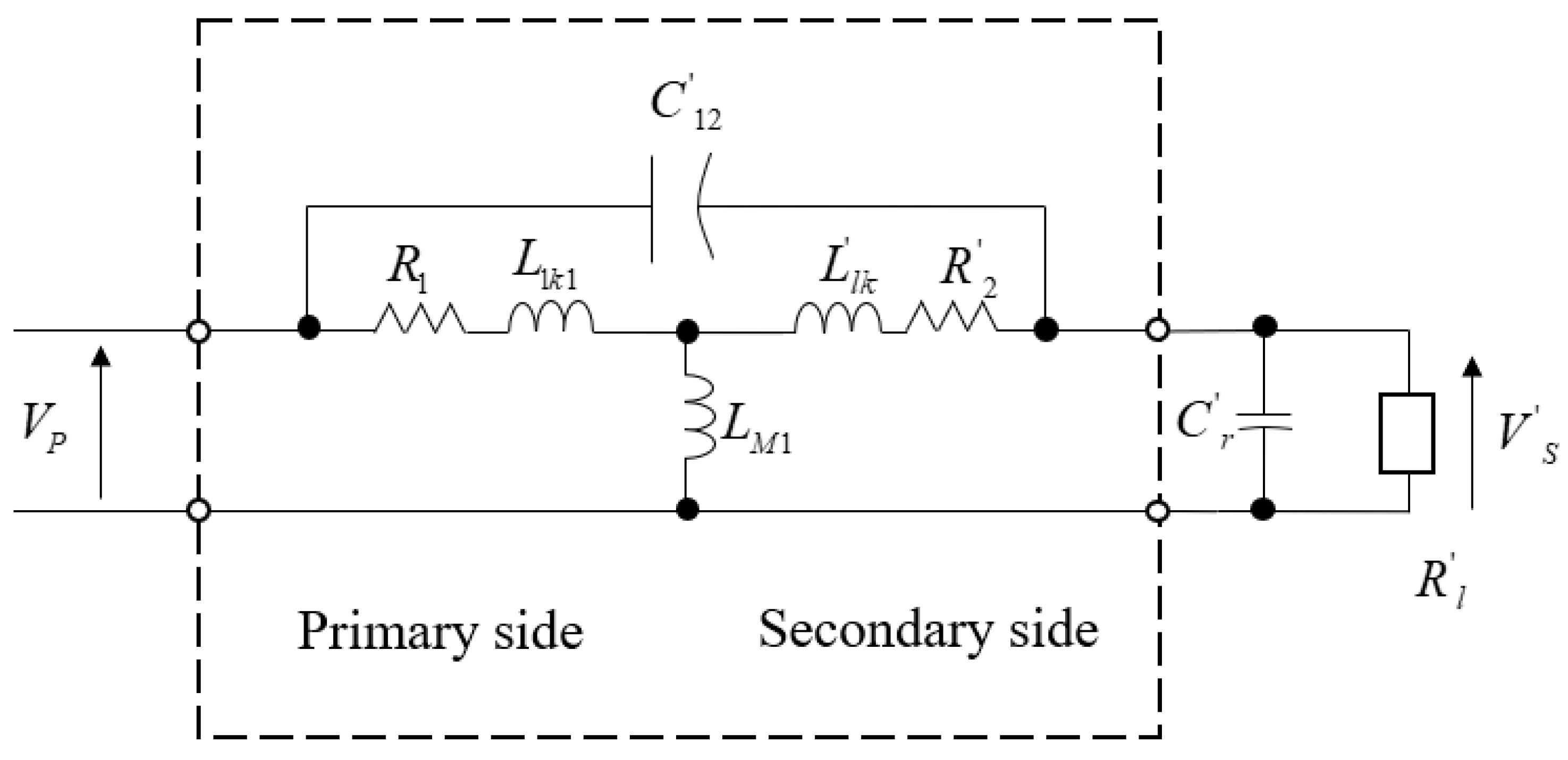
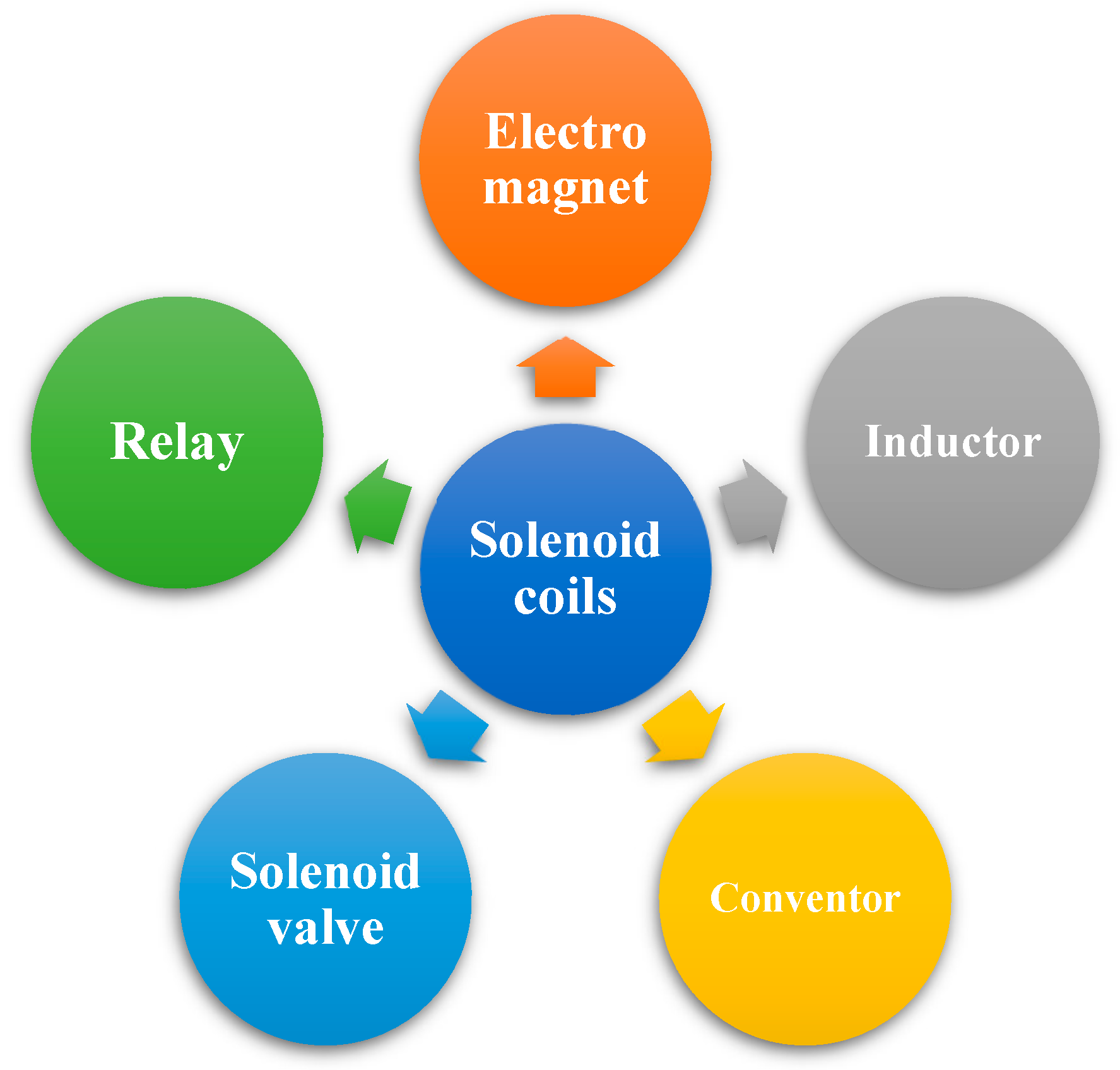
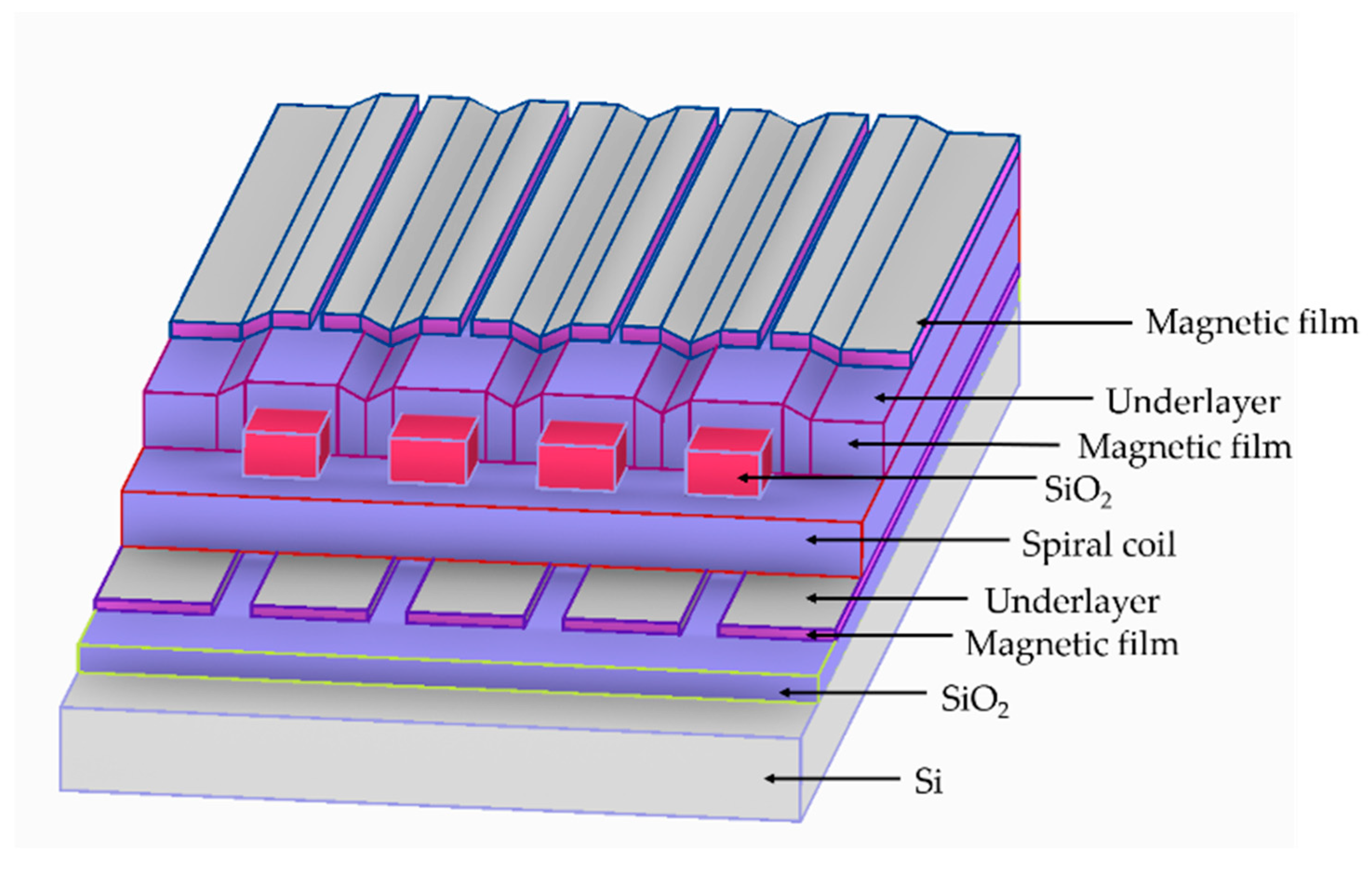
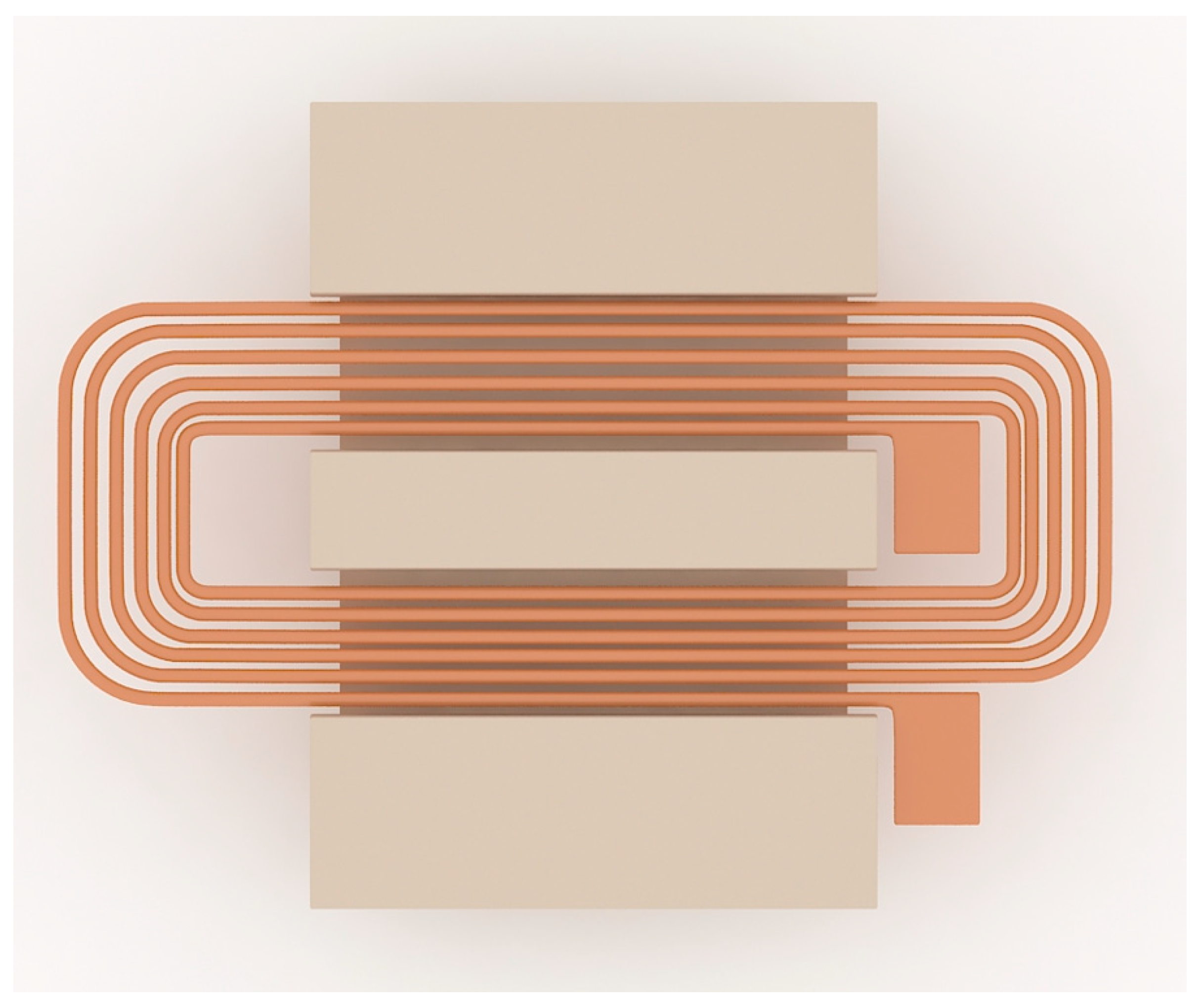
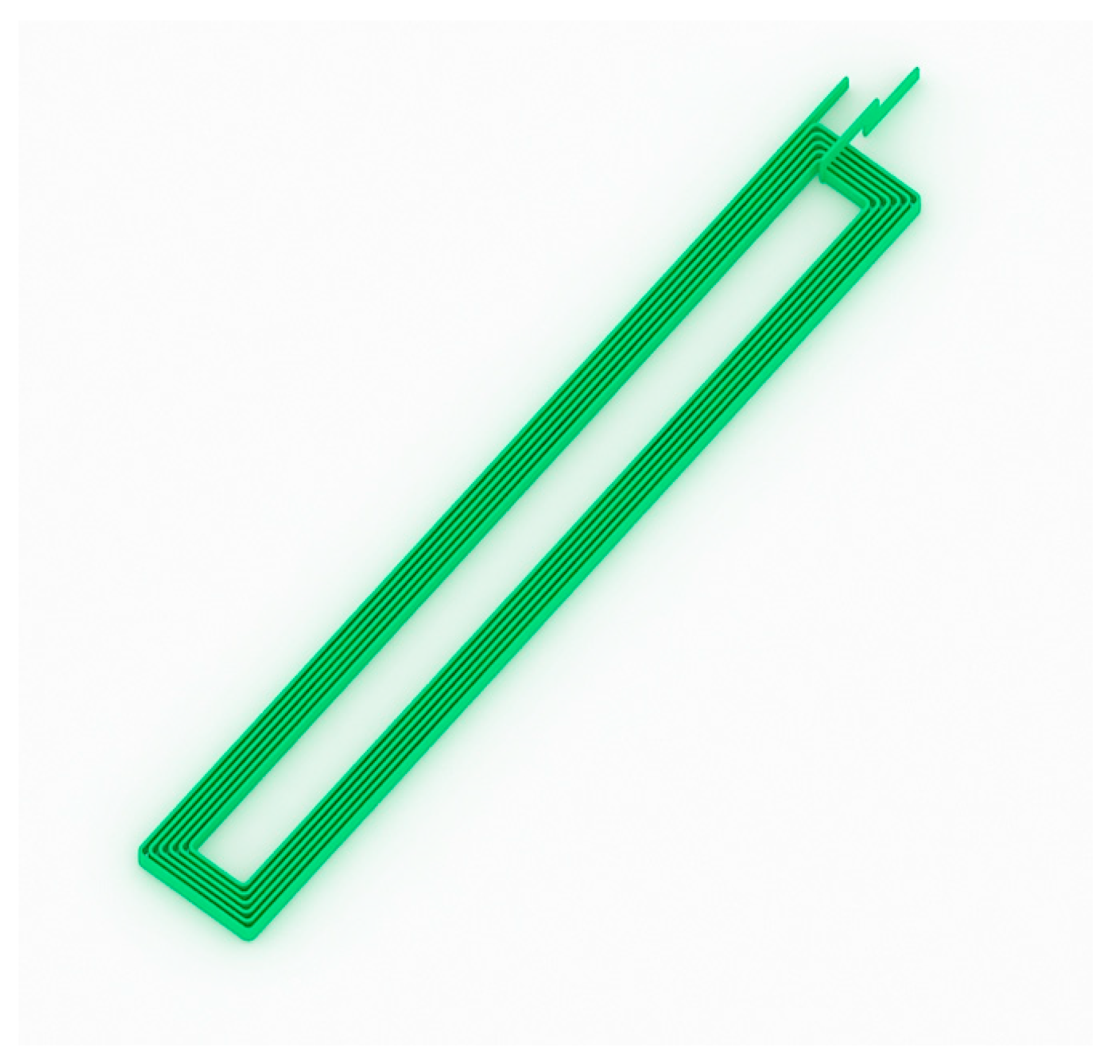
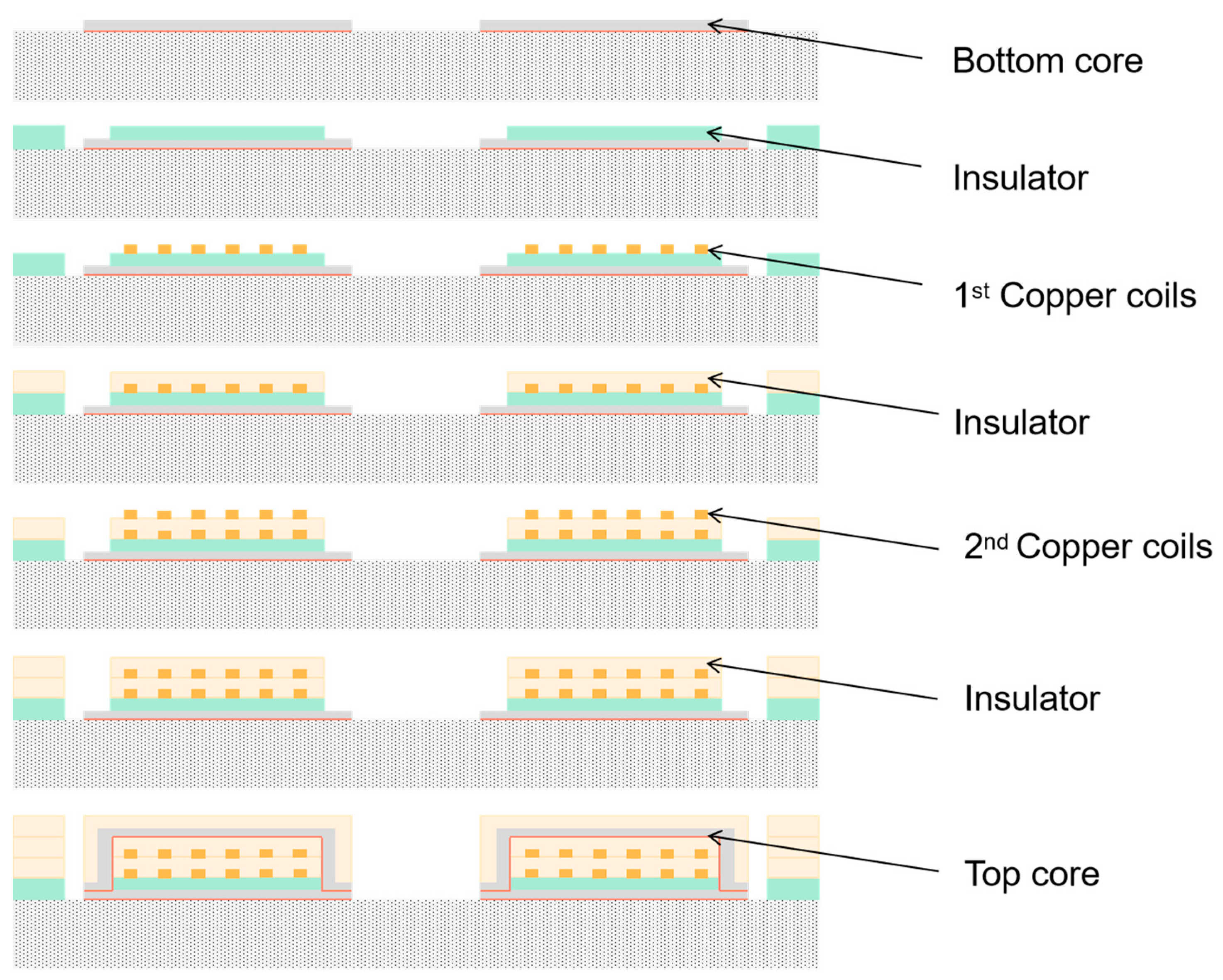
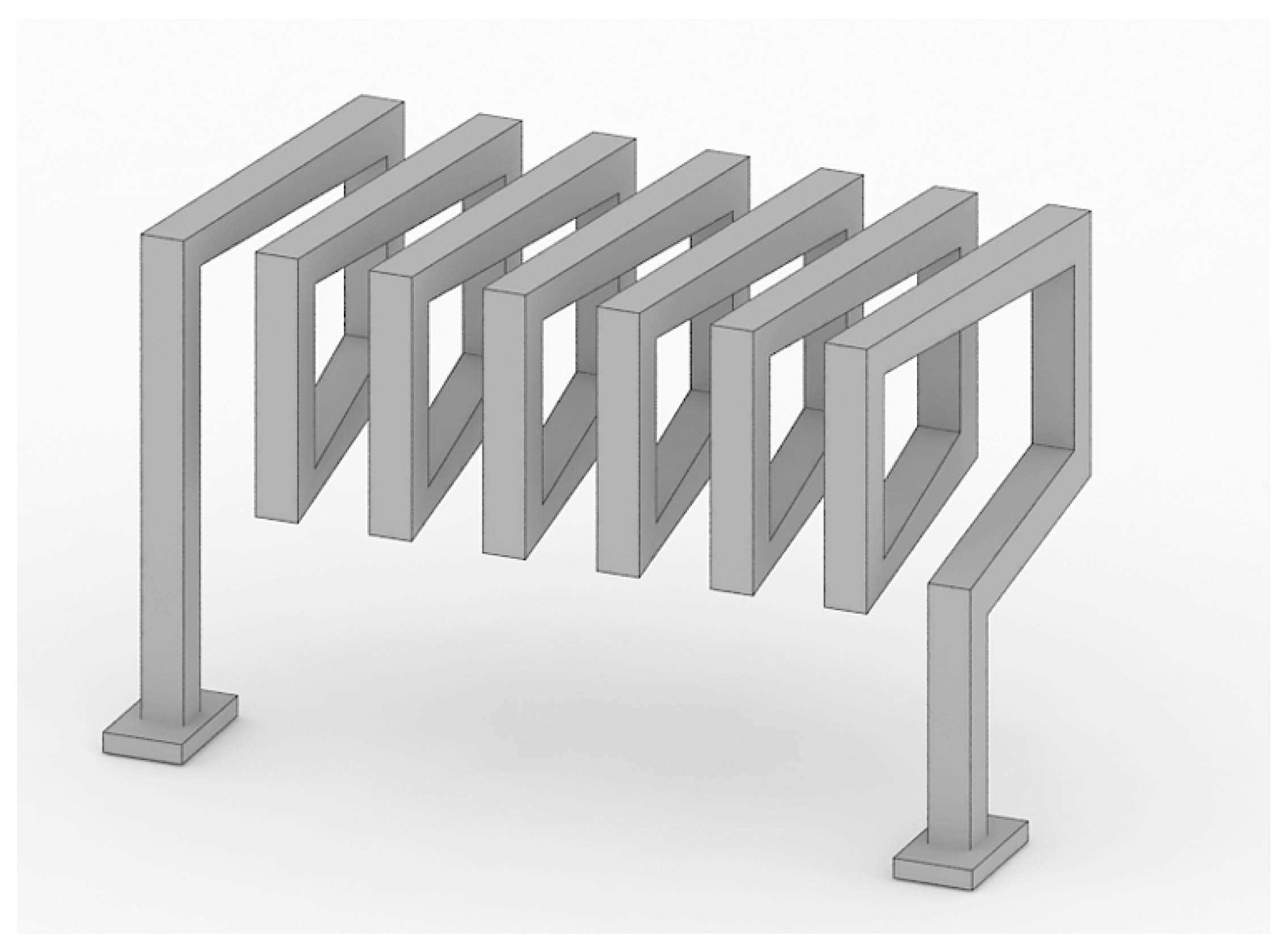
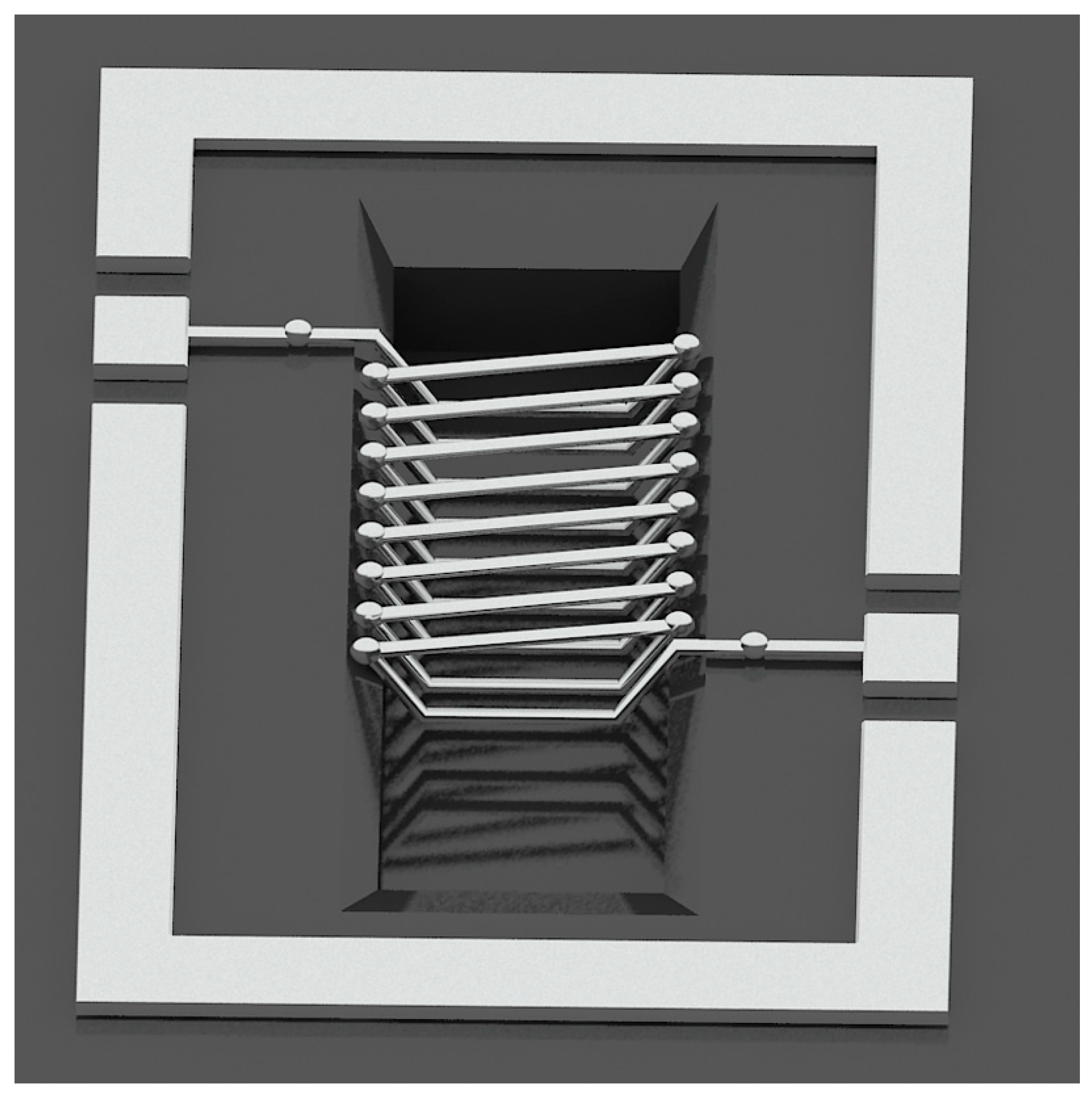
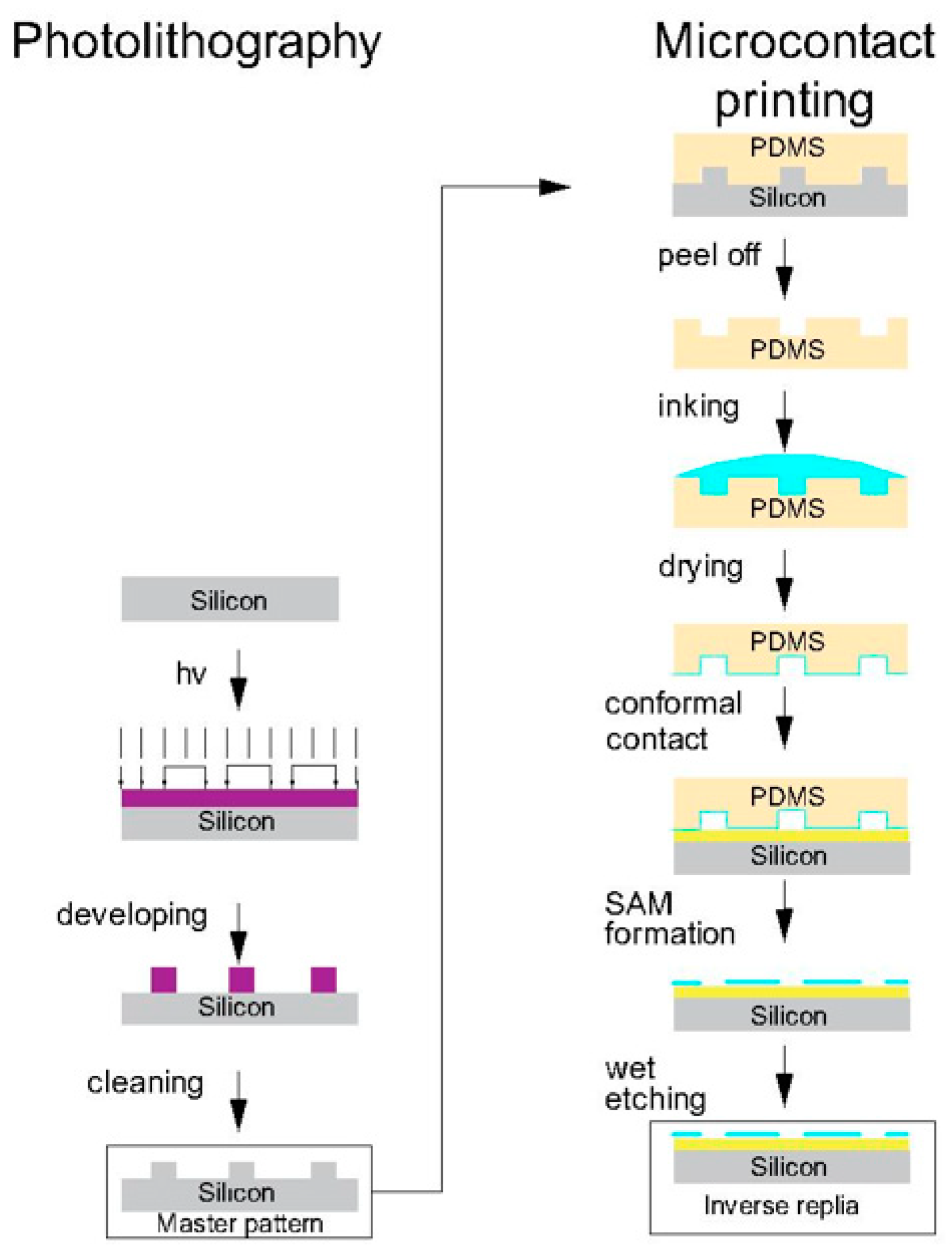
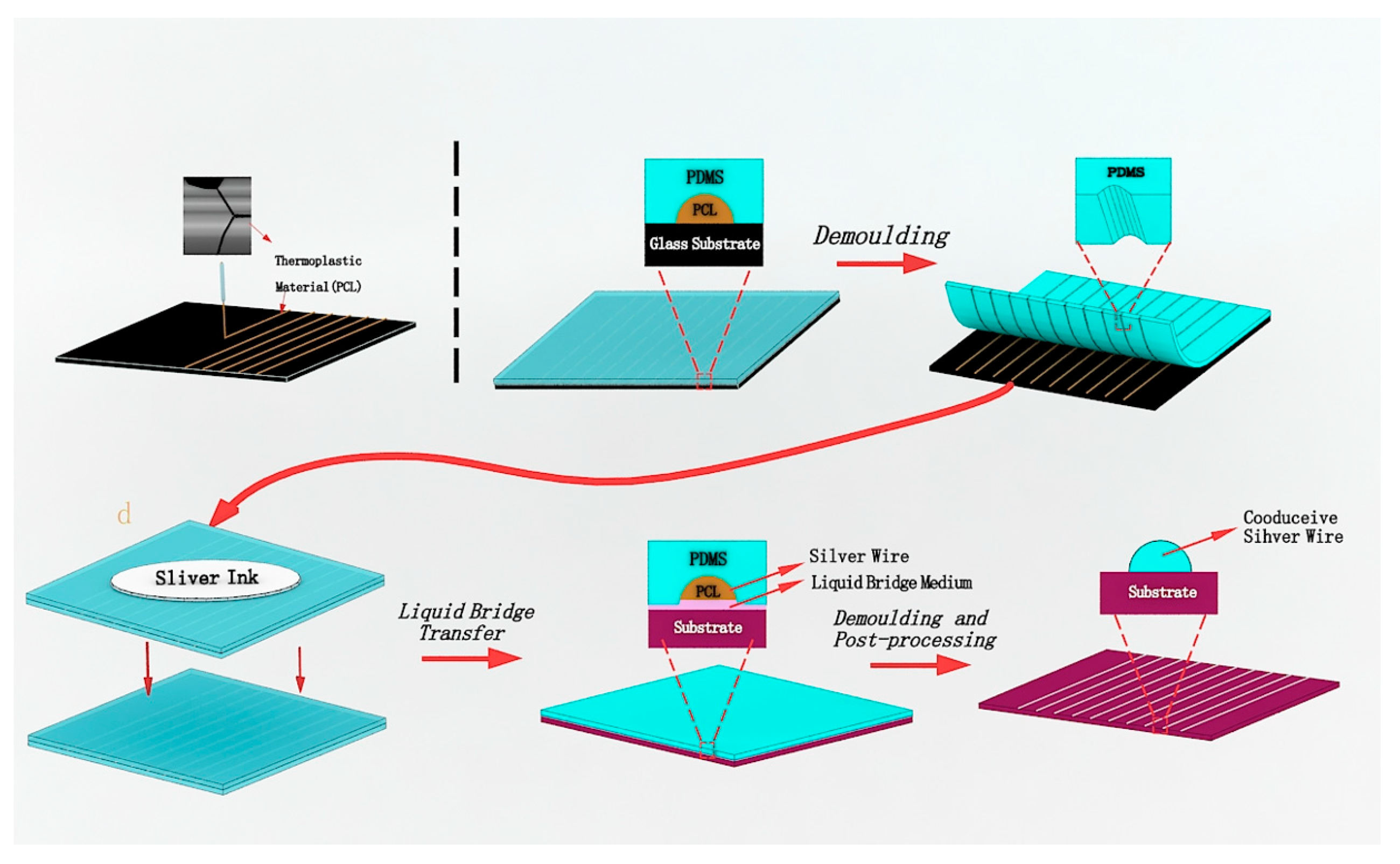
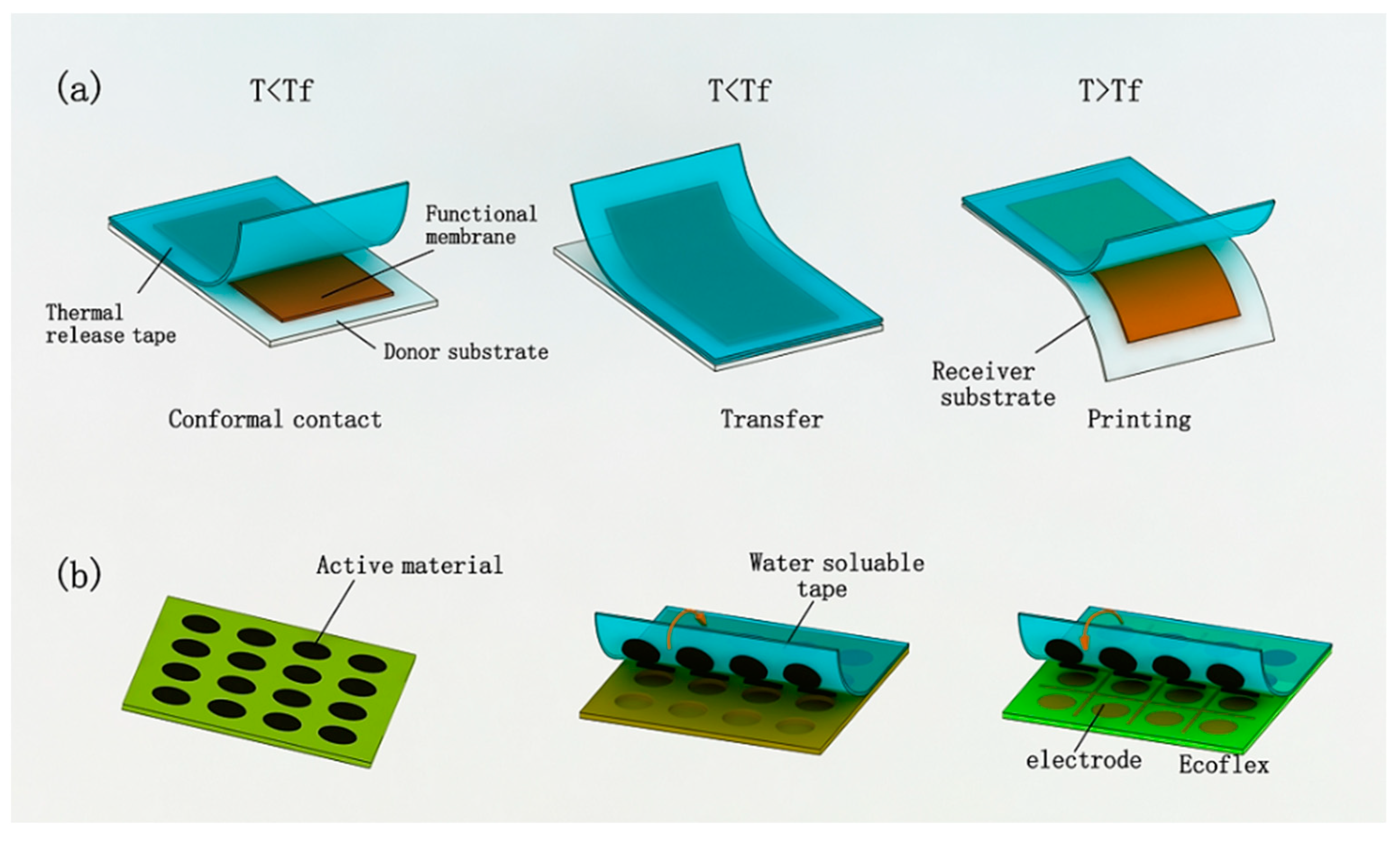
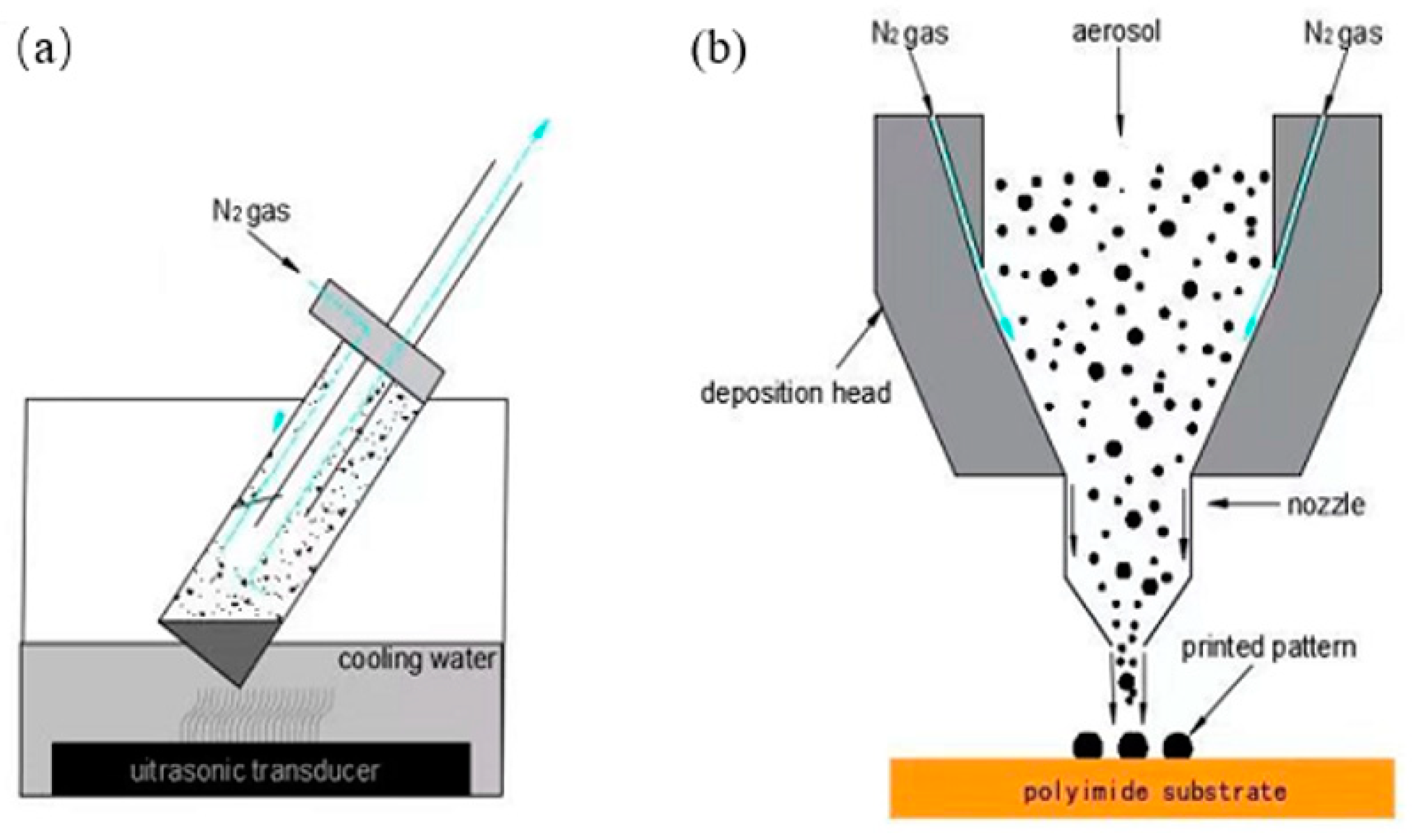
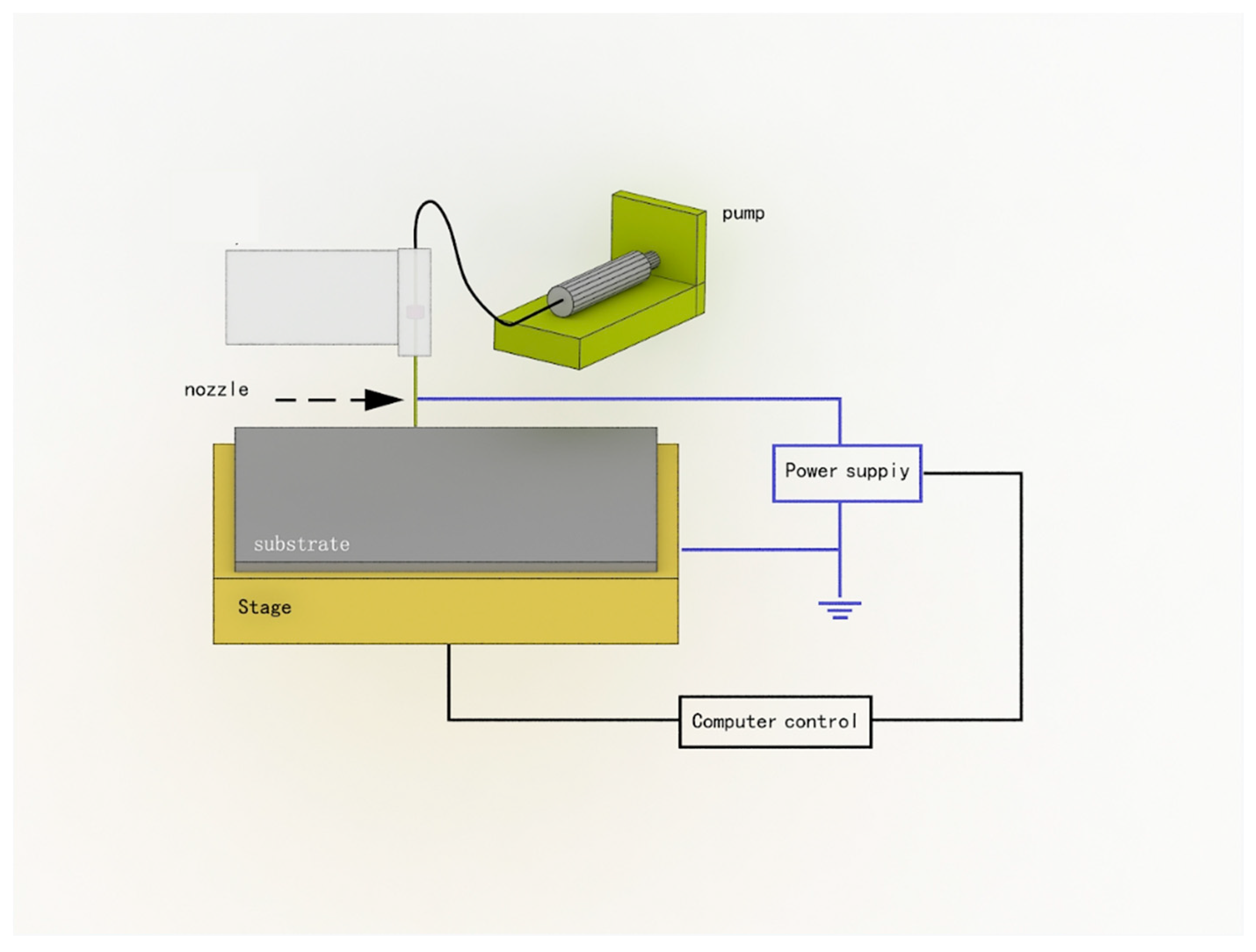
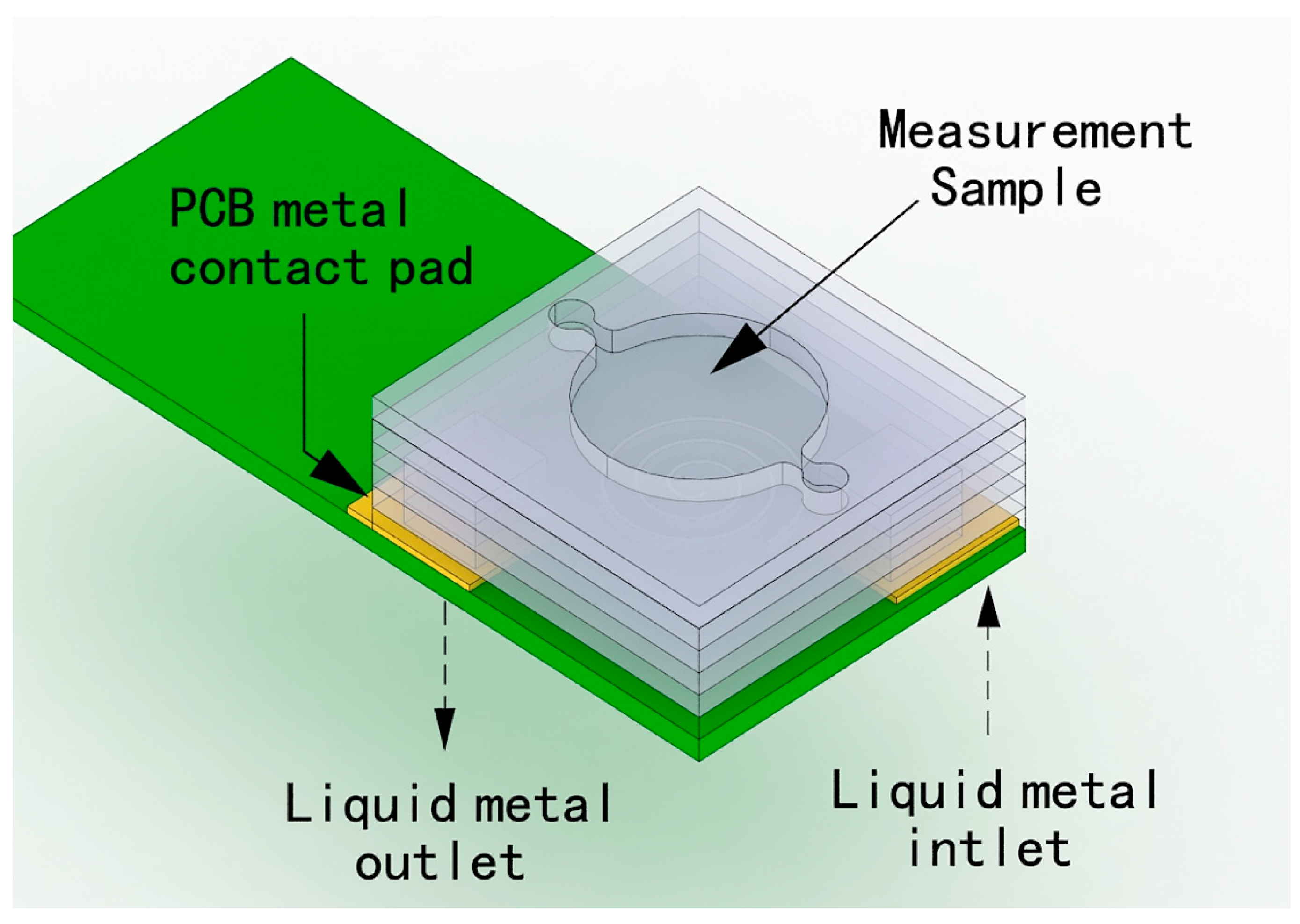
| Coil Type | Ref. | Size | Coil Materials | Applications |
|---|---|---|---|---|
| Processing on PCB | Wei et al. [68] | 5 mm | copper | NMR probe |
| Tang et al. [56] | 4.6 mm | copper | Isolated Switching Power Converters | |
| Hand winding | Peck et al. [69] | 50 μm–1.8 mm | copper | NMR detection in the laboratory |
| Wire bonding | Kratt et al. [70] | 300 μm | insulated bondable gold wire | Experiment |
| Coil Type | Ref. | Special Design Structure | Size | Resistance (mΩ) | Frequency (MHz) | Inductance Value (nH) | Q |
|---|---|---|---|---|---|---|---|
| Single-layer planar coil | Yamaguchi M, et al. [46] | Sandwich construction | – | 6800 | 1000 | 7.7 | 7 |
| 2000 | 7.9 × 106 | 12.7 | |||||
| Peng S, et al. [75] | Sandwich structure with electroplated NiFe as the magnetic core | 1.7 × 1.7 mm2 | 470 | 21.7 | 204 | – | |
| 9.2 | – | 9.23 | |||||
| Olivo J, et al. [77] | High thickness spiral inductor, coil thickness is 60 um | 14.88 × 2 mm2 | 1058 | 5 | 460 | 13.65 | |
| Multilayer planar coil | Xuming Sun, et al. [51] | Parylene-based 3D high-performance folded multilayer inductors | 2.1 × 2.1 mm2 | – | 4.1 | 427.9 (A layer of the coil) | 7.48 |
| 12,790 (Six layers of the coil) | 10.68 | ||||||
| Solenoid coil | Dragan Dinulovic, et al. [48] | Soft magnetic CZT (Co–Zr–Ta) material as the core material | 2.6 × 2.4 × 0.4 mm3 (L × W × T) | 320 | 15 | 100 | – |
| 30 | 97 | 15 | |||||
| Lei Gu, et al. [83] | The solenoid inductor is embedded in the silicon cavity | – | 1270 | 5350 | 45 | – |
| Type of Substrate | References | Substrate Materials | Coil Materials | Advantages | Applications |
|---|---|---|---|---|---|
| rigid | Jiang Q, et al. [27] | Glass | Cu | High light transmittance, high hardness, corrosion resistance | ME sensor |
| Wang N, et al. [63] | Si | Cu | Excellent piezoresistive properties, easily oxidized to form a layer of silica on the surface (insulating layer) | Micro-transformers | |
| flexible | Xuming Sun, et al. [51] | Parylene substrate | Cu | Biocompatibility, flexibility, chemical inertness and optical transparency | Wireless power transmission applications |
| Woytasik M, et al. [84] | Kapton and Peek | Cu | Physicochemical stability, flexibility | Non-destructive testing (NDT) techniques |
| Reference | Insulating Layer | Temperature (°C) | Insulation Resistance (MΩ) |
|---|---|---|---|
| Nakai H, et al. [85] | 6.5 μm alumina | 820 | >10 |
| J.Y. Park, et al. [86] | Thermal oxide layer + sputtering alumina on the NiCoCrAlY transition layer | 1027 | >1 |
| Thermal oxide layer + the sputtering alumina composite insulation layer on the FeCrAlY transition layer | 1027 | >0.1 | |
| John D, et al. [87] | Composited with 1 μm CrC and 4 μm Al2O3 | 690 | 84 |
| 750 | 20 | ||
| Composited with 1 μm ZrO2/Y2O3 and 4 μm Al2O3 | 690 | 50 | |
| 750 | 17 | ||
| 900 | 1.8 |
| Process | Deposition Rate | Sedimentary Area | Cost of Equipment | Equipment Complexity | Difficulty Level |
|---|---|---|---|---|---|
| Electroplate | Quick | Large | Low | Low | Simple |
| Sputtering deposition | Medium | Large | High | High | Medium |
| Vacuum evaporation | Slow | larger | High | Medium | Medium |
| Methods | CVD | PVD | Electroplating | |
|---|---|---|---|---|
| Electroless | Electrolytic | |||
| Impurities | C, O | Ar | Seed layer | – |
| Deposition rate (nm/min) | ~100 | ≥100 | <100 | ~200 |
| Process temperature (°C) | ~250 | RT | 50~60 | RT |
| Step coverage | Good | Fair | Good | Good |
| Via fill capability | Good | Poor | Fair–poor | Fair–poor |
| Environmental(waste) | Good | Good | Poor | Poor |
| Methods | Transfer of Material | Stamp | Acceptor Substrate | Sizes (μm) |
|---|---|---|---|---|
| Rate-based transfer printing method | Si | PDMS | GaAs, InP | 0.3 |
| Cu | PDMS | PDMS | 100 | |
| PZT | PDMS | PDMS | 300 | |
| Ag/MgF2 | PDMS | PDMS | 0.225 | |
| GaAg | PDMS | PI | – | |
| Micro-structure-based transfer printing method | Si | PDMS | Quartz | 100 |
| InGaAs | PDMS | PI, PET, Si | 50 | |
| Au, Ag, Cu | Hydrogels | PET, PVC | 20 | |
| Si | PDMS | Glass | 15 | |
| Tape-based transfer printing method | LiCoO2/Li4Ti5O12 | Tape | Ecoflex | 1580 |
| Si | Tape | PI | 250 | |
| AuNPs | Tape | Al | 10 | |
| Au/PI | Tape | PDMS | – | |
| Sacrificial layer transfer printing method | MOS device | PDMS | PDMS | – |
| PDMS | PET | – | ||
| SWNT | PU | PI | – |
| Product | Manufacturer | Conductive Material | Solid Content | Viscosity | Applicable Process |
|---|---|---|---|---|---|
| EI–1104 | Eletroinks | Ag | 14 wt% | 10 cps | Ink-jet printing |
| EI–906 | Eletroinks | Ag/AgCl | 30 wt% | 16,000 cps | Silk screen printing |
| Ink10 | FUDY | Ag (10 nm) | 35 wt% | 5–30 cps | Ink-jet printing |
| CON–INK550 | Dahua Brocade | Ag (30 nm) | 25–30 wt% | 5–6 cps | Ink-jet printing |
| Processing Technology | Device | Advantage | Application |
|---|---|---|---|
| Macro processing method | Detection probe | Low cost, not easily oxidized | Detection equipment such as NMR machines |
| Manual winding coil on capillary | The method is simple and suitable for manual operation | Detection of coil preparation parameters under laboratory conditions | |
| Experimental detection coil | Novel methods with the potential for mass production | Integrated micro-inductor | |
| MEMS Machining Method | WPT system | Wireless transmission, high Q value and high inductance increase the transmission distance and energy | Power supply for devices such as cochlear implants in biomedical fields |
| Isolation miniature transformer | Small footprint, high coupling, high-voltage gain and low DCR, suitable for signal conversion in the frequency range of tens of MHz | Automotive electronics, industrial electronics, etc. | |
| Three-axis magnetic sensor | Surface sensor detection | Wearable equipment, nondestructive testing (NDT) | |
| Energy harvesting | Large functional density and small size of the devices | Health and Use Monitoring System for Defense Military Helicopters (HUMS) | |
| Printing technology | Array electromagnetic Sensor | High density, microwire width detection coil | Nondestructive electromagnetic testing field |
| Transparent conductive grid | Large aspect ratio, high resolution, large area fabrication | Touch screen, organic solar cell, transparent display | |
| Liquid metals | Multilayer integrated NMR microcoil | Good mechanical deformation ability | Tuned fluid antenna, pressure sensor, energy harvester and other devices need high precision, high complexity, high mechanical strength processing |
| Femtosecond laser | 3D spiral microcoil | More uniform, good performance, able to meet the practical application requirements | Micromechanical systems, microelectronic devices, micro sensors and other fields of micro-system integration |
Publisher’s Note: MDPI stays neutral with regard to jurisdictional claims in published maps and institutional affiliations. |
© 2022 by the authors. Licensee MDPI, Basel, Switzerland. This article is an open access article distributed under the terms and conditions of the Creative Commons Attribution (CC BY) license (https://creativecommons.org/licenses/by/4.0/).
Share and Cite
Lou, J.; Ren, H.; Chao, X.; Chen, K.; Bai, H.; Wang, Z. Recent Progress in the Preparation Technologies for Micro Metal Coils. Micromachines 2022, 13, 872. https://doi.org/10.3390/mi13060872
Lou J, Ren H, Chao X, Chen K, Bai H, Wang Z. Recent Progress in the Preparation Technologies for Micro Metal Coils. Micromachines. 2022; 13(6):872. https://doi.org/10.3390/mi13060872
Chicago/Turabian StyleLou, Jianyong, Haixia Ren, Xia Chao, Kesong Chen, Haodong Bai, and Zhengyue Wang. 2022. "Recent Progress in the Preparation Technologies for Micro Metal Coils" Micromachines 13, no. 6: 872. https://doi.org/10.3390/mi13060872
APA StyleLou, J., Ren, H., Chao, X., Chen, K., Bai, H., & Wang, Z. (2022). Recent Progress in the Preparation Technologies for Micro Metal Coils. Micromachines, 13(6), 872. https://doi.org/10.3390/mi13060872






